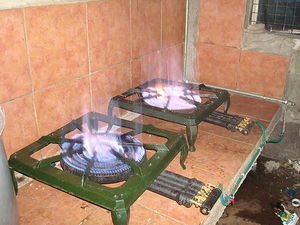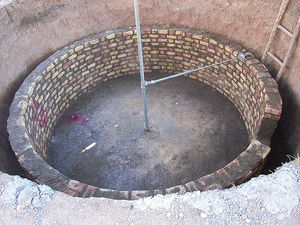Biogas: Difference between revisions
m (Wiki syntax.) |
|||
| Line 14: | Line 14: | ||
== Applications and Product Ecology == | == Applications and Product Ecology == | ||
* biogas for cooking, heating | * biogas for cooking, heating | ||
* [ | * [[CEB Vaults|Guastavino masonry]] or plain CEBs to build biogas digester and holding tank for stored biogas. One holding tank could be used for the storage of biogas and [[Compressed Fuel Gas|Compressed fuel gas]]. | ||
* methane for the production of [ | * methane for the production of [[Direct Reduced Iron|Direct reduced iron]] from rust or high-grade iron ore. | ||
* compressed biogas for transportation / internal combustion engine | * compressed biogas for transportation / internal combustion engine | ||
* liquid slurry from biogas tank can be used to fertilize [[duckweed]] pond | * liquid slurry from biogas tank can be used to fertilize [[duckweed]] pond | ||
* solid contents coming out of digester can be composted (vermicompost, BSF compost, [[biochar]] compost) | * solid contents coming out of digester can be composted (vermicompost, BSF compost, [[biochar]] compost) | ||
* when biogas is burned inside a greenhouse, the CO2 enrichment can provide a boost to plant growth (CO2 concentrations up to 1500ppm are beneficial). This is effect widely used by commercial growers, but unfortunately they are using mostly fossil methane. | * when biogas is burned inside a greenhouse, the CO2 enrichment can provide a boost to plant growth (CO2 concentrations up to 1500ppm are beneficial). This is effect widely used by commercial growers, but unfortunately they are using mostly fossil methane. | ||
* various uses in [ | * various uses in [[:Category:Metalworks|metallurgy]] | ||
* process bulky biomass before it can go into a digester, using [[hammer mill]] | * process bulky biomass before it can go into a digester, using [[Hammer Mill|hammer mill]] | ||
== External Links == | == External Links == | ||
Revision as of 00:07, 3 August 2012
Challenges
Biogas production can be problematic in temperate climates: low temperatures may lead to breakdown of microbial populations. This can potentially be overcome with insulation or earth sheltering.
Biogas can be dirty (high sulfur content etc.) Use of biogas: when used for combustion, no upgrading necessary. When intended use is internal combustion engine (transportation), biogas may need to be upgraded (cleaned).
Simple Open Source Biogas System
Supergas - In 1996-97 Superflex collaborated with biogas engineer Jan Mallan to construct a simple, portable biogas unit that can produce sufficient gas for the cooking and lighting needs of an African family. The system has been adapted to meet the efficiency and style demands of a modern African consumer. It is intended to match the needs and economic resources that we believe exist in small-scale economies. The orange biogas plant produces biogas from organic materials, such as human and animal stools. For a modest sum, a family will be able to buy such a biogas system and achieve self-sufficiency in energy. The plant produces approx. 3-4 cubic meters of gas per day of the dung from 2-3 cattle. This is enough for a family of 8-10 members for cooking purposes and to run one gas lamp in the evening.
Applications and Product Ecology
- biogas for cooking, heating
- Guastavino masonry or plain CEBs to build biogas digester and holding tank for stored biogas. One holding tank could be used for the storage of biogas and Compressed fuel gas.
- methane for the production of Direct reduced iron from rust or high-grade iron ore.
- compressed biogas for transportation / internal combustion engine
- liquid slurry from biogas tank can be used to fertilize duckweed pond
- solid contents coming out of digester can be composted (vermicompost, BSF compost, biochar compost)
- when biogas is burned inside a greenhouse, the CO2 enrichment can provide a boost to plant growth (CO2 concentrations up to 1500ppm are beneficial). This is effect widely used by commercial growers, but unfortunately they are using mostly fossil methane.
- various uses in metallurgy
- process bulky biomass before it can go into a digester, using hammer mill
External Links
- Appropedia Category: Biogas
- Appropedia main biogas page
- Wikipedia: Biogas
- p2pfoundation Category:Biofuel
- DIY Biogas - Germany

